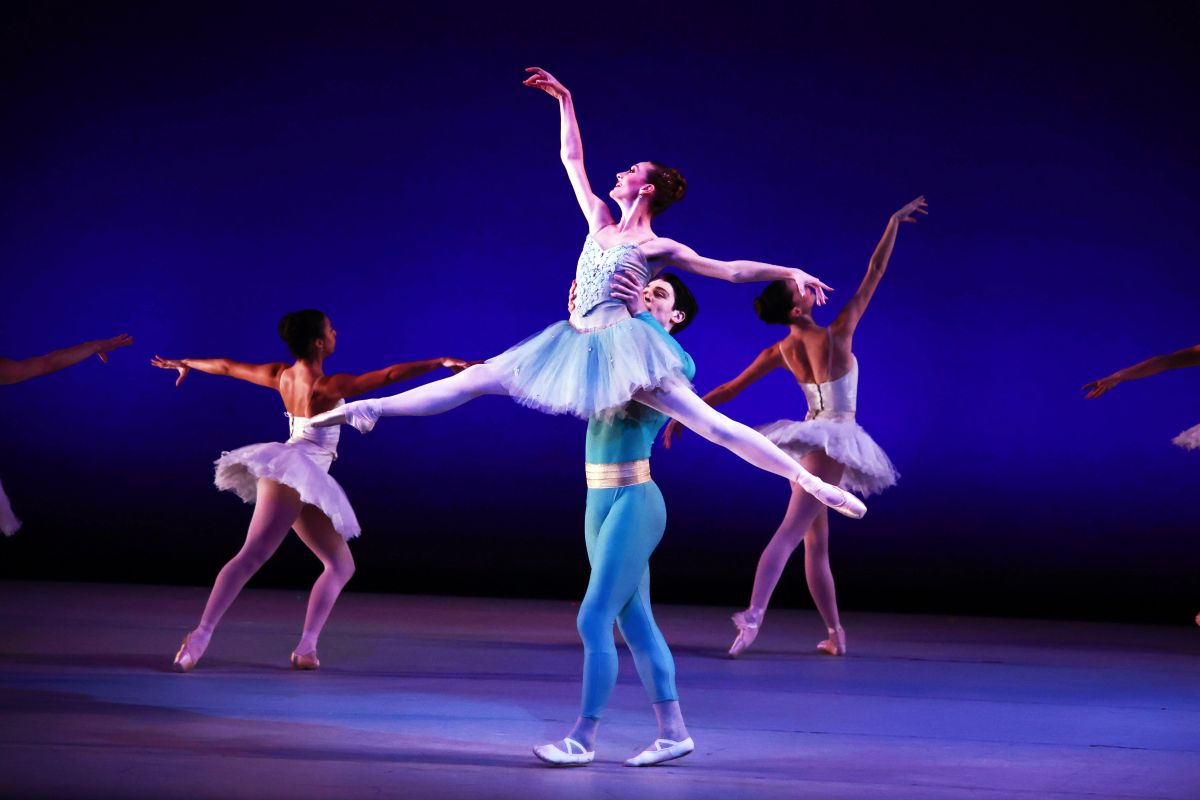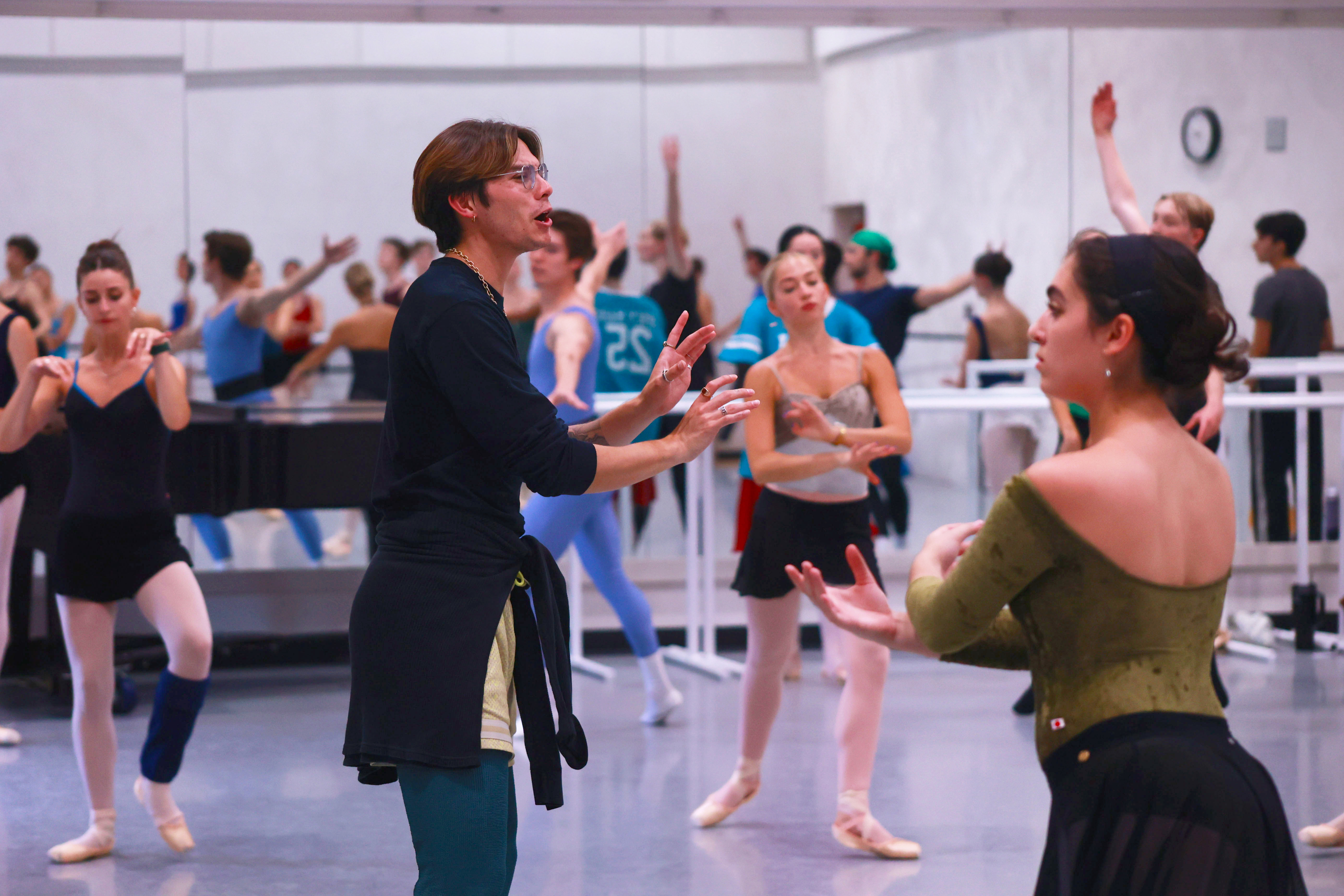Durante Verzola: My name is Durante Verzola and I am the resident choreographer at the Miami City Ballet School, and I live in Miami, Florida. And I am here working with Indiana University's Ballet on restaging one of my works called Mouvement Joyeux, with music by Mozart. I didn't name it till after it was done, but after it was done I saw the joy of dancing, and it was also one of my first works after the pandemic to be on stage. And so, you know, I think to have the stage and the lights and the theatricality of everything again, I wanted the dancers to feel that joy through the movement. I actually chose three different selections from three different works of Mozart’s that highlight the piano. The first movement is from his Sonata for Two Pianos in D Major, just the first movement of that. Each of the movements, I think, has its own unique flavor and perfume. The first movement highlights these two principal female dancers, and so there's lots of technical point work in there. And then it's kind of a call and response between those two dancers and then a group of demi-soloist dancers that break off into trios and quartets. I wanted it to kind of just be a big dance explosion, the first movement. Lots of steps. It's definitely hard for them, stamina-wise and technically.
And then the second movement of the ballet is his Piano Concerto Number 21, the Adagio movement from that. The second movement is very dreamy. I tell the dancers, you know, it's like you're dancing up in the clouds. There's these five demi-soloists that first come out, and I said it's like you're these five muses that are inspiring the couple whenever they come out to dance. A departure from the first movement.
And then the third movement is from his Concerto for Two Pianos Number 10, and the final Rondo movement of that piece. And it's led by a male soloist with lots of energy, again, a full corps de ballet, and all of the dancers from the other movements come back, too, and kind of…you know, it's the first time they're encountering each other. And so having that enjoyment of dancing all together on stage, just moving to beautiful, big music was what I wanted to show.
Aaron Cain: It's always amazing to me when I speak with choreographers and with dancers about inspiration.
Durante Verzola: Right.
Aaron Cain: So was there something about the piano that spoke to you?
Durante Verzola: All of my works come from the music. That is the first piece of inspiration. And from there, images of dance and a structure comes about based on the music. And since Mozart highlights the piano so much in these works, I kind of used that to arrange my principals and soloists and demi-soloists. So there's always a principal dancer of the work dancing on the piano part of the music and representing that sound. And then, for the most part, I have the corps de ballet or the demi-soloists representing the orchestra. It really comes from the way that I was trained as a dancer, that the music is always the impetus for movement. I listen to the music a lot. I fall asleep listening to the music. So it's just in my body. So that once I get into the studio I can transform these notes into movement.
And so I think a lot of the corrections I've been giving to the IU dancers is to, really…it's like their feet are playing the piano keys, or that they have that internal pedal of the piano that sustains the notes, that they hold on to every single last note, that they're sharp and precise whenever the music is a little bit sharper and livelier. I think whenever dancers are able to find that complete harmony between music and movement, then they are the most free and, in turn, they can inspire the audience to feel free or to relate to the movement or to be touched or affected by what they're seeing up on stage. But it has to be musical. At the same time, even though I'm specific about the musicality, I want them to be their individual selves at the same time; to feel artistic and expressive through moving. And because the piece doesn't have a narrative to it, they have to kind of let themselves come out and feel expressive so that the audience does feel something whenever they're watching the work.
Aaron Cain: Durante Verzola, thank you so much for speaking with me today about this project, and we look forward to seeing it.
Durante Verzola: Thank you so much.
Aaron Cain: Durante Verzola. Choreographer of Mouvement Joyeux, the first of four works performed as part of Fall Ballet, starting Friday night at 7:30 at the Musical Arts Center, with two more performances Saturday at 2:00 PM and 7:30 PM. More information at operaballet.indiana.edu. For WFIU arts, I'm Aaron Cain.








